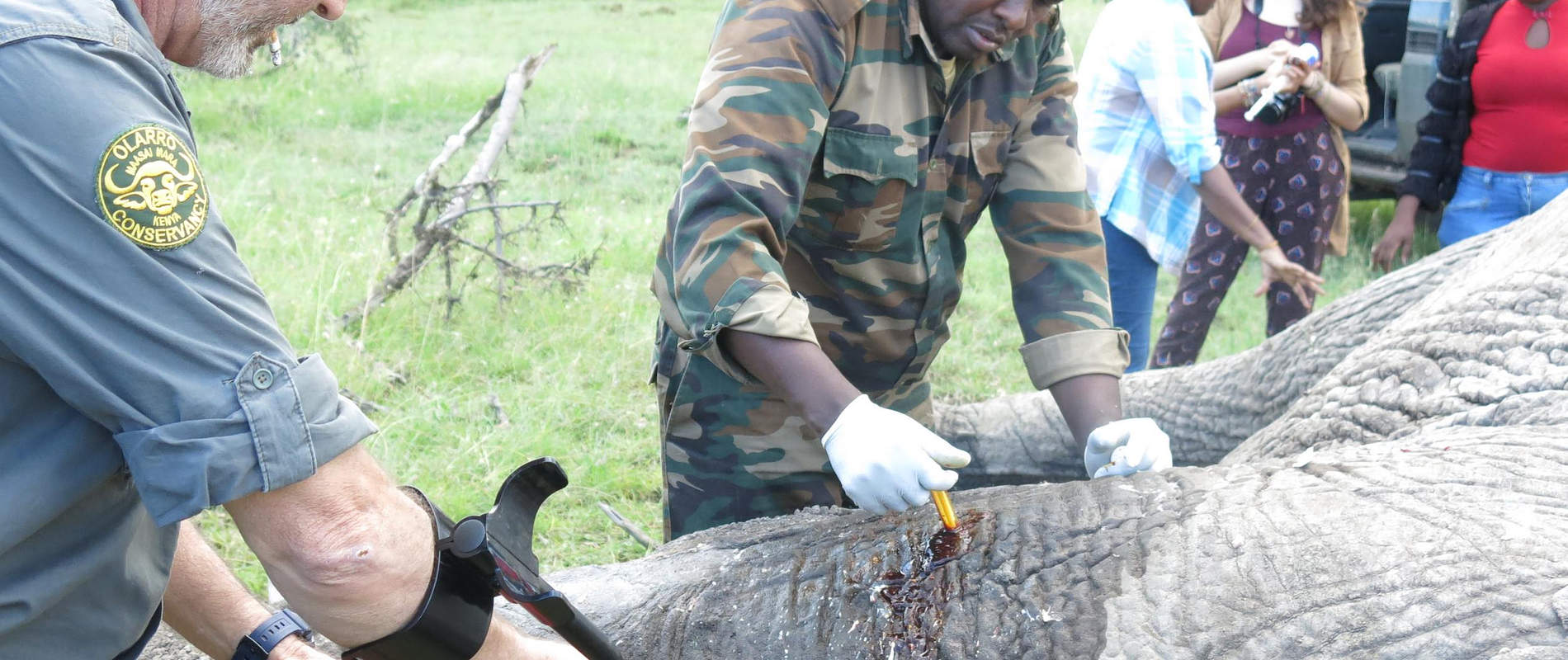FIELD VETERINARY REPORT FROM MASAI MARA-MAY 2018 By Dr
FIELD VETERINARY REPORT FROM MASAI MARA-MAY 2018
By Dr. Campaign Limo
Introduction;
Like most parts of the country, Mara and the surrounding areas continue to receive rainfall with notable floods occurring in some areas. Mobility has been hampered considerably by overflowing luggas, seasonal rivers and swamps. The human-elephant conflict experienced around Olarro conservancy continued with a number of elephants being immobilised and examined for treatment. Others were considered out of danger and monitoring was advised.
The following cases were handled during the period under review;
CASE#1 INJURED BULL ELEPHANT
Date: 8th May 2018
Species: African elephant
Sex: Male
Age: Approximately 18 years
Location: Olkinyei/Kishermuruak
History
This elephant was seen limping on his front right limb by KWS, Mara Elephant Project and Olkinyei Conservancy Rangers while on their patrol. They notified the veterinary unit for intervention. This bull was found up a hill with another bigger bull, both having detached themselves from a bigger herd of about 12 elephants. He showed severe limping when walking, favouring his right front leg. A big discharging wound could be seen on his right shoulder giving him problems with ambulation.
Immobilization, examination and treatment
This young bull could not be approached by foot or vehicle as he was in a thicket up a hill. The team requested a helicopter to push the elephant down the hill into a relatively open area. The elephant was successfully darted with 13mgs Etorphine hydrochloride through a 1.5ml dan-inject dart from the helicopter. It took seven minutes for the drugs to take full effect with this young bull assuming right lateral recumbency. For proper examination and treatment this elephant was rolled over to expose the injuries.
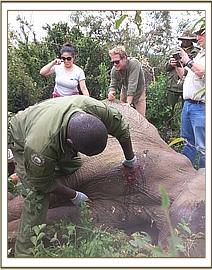

Examination revealed a spear wound which penetrated the pinna of his right ear accessing the right shoulder. The injury to the shoulder was deep and infected with purulent discharge. The wounds were thoroughly cleaned and debrided with the help of hydrogen peroxide. Copious amount of clean water was used for rinsing the wound before it was disinfected with tincture of iodine. Green clay was finally packed into the wound to absorb toxins and hasten healing.
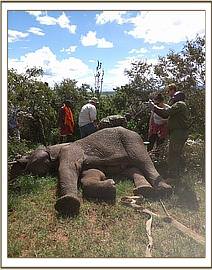

Additional treatments include intramuscular administration of 22500mgs amoxicillin antibiotics and 5000mgs flunixin meglumine anti-inflammatories.
Reversal and Prognosis
The anaesthetic was reversed by intravenous administration of 36mgs Diprenorphine hydrochloride delivered through a prominent ear vein. He woke up within four minutes made a mock charge to the team before retreating to join his companion. His prognosis for recovery is good.
CASE#2 ELEPHANT RE-COLLARING
Date: 8th May 2018
Species: African elephant
Sex: Female
Age: Adult
Location: Naboisho Conservancy.
History
KWS, Mara Elephant Project and the County government of Narok agreed to deploy collars on elephants within Mara Ecosystem for monitoring purposes. This will hopefully increase their security and reduce human wildlife conflict. A matriarch called Caroline was collared three years ago and has been providing helpful information, however the lifespan of her collar was coming to an end. There was need to replace her collar.
Immobilization and collar replacement
Given the nature of the terrain and current prevailing weather conditions, it was only feasible to carry out this activity with the assistance of a helicopter. She was found on top of a hill with a relatively big herd. After being pushed to an open and flat area, she was darted with 15mgs Etorphine hydrochloride in a 1.5ml dan-inject dart from the helicopter. She crossed a Lugga before the narcotics took effect and assumed sternal recumbency. A quick physical examination revealed she was in good body condition and the old collar was removed and replaced with another one quickly because of her compromised posture. Parameters were monitored throughout and she was reversed as soon as the collar was in place with 36mgs Diprenorphine hydrochloride given intravenously through a prominent ear vein. She was up in three minutes to join the rest of the herd.
CASE#3 INJURED ELEPHANT
Date: 10th May 2018
Species: African elephant
Sex: Female
Age: Adult
Location: Ngoswani
History
This elephant was seen with a swollen left precruris by the Olarro conservancy and Mara Elephant Project teams on patrol following a spate of spearings and arrow wounds to elephants recorded near Olarro in the recent past. This female was among hundreds of elephants aggregated around this area who have stayed there for some time now. They called the Veterinary unit for intervention. Given the terrain, weather and numbers of elephants in the area, it was only feasible to search, identify and isolate the injured elephant by use of a helicopter. After some minutes scanning the herd, the injured one was positively identified as a female with a two to three year old calf in the midst of the herd.
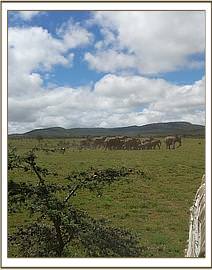

Immobilization, examination and treatment
The injured elephant was isolated from the bigger herd and moved to a relatively open area where she was darted with 16mgs Etorphine delivered through a 3ml dan-inject dart from the helicopter. It took seven minutes for the drugs to take and she assumed left lateral recumbency. In this position, an infected spear wound to her right shoulder was discovered. It was cleaned with copious amounts of water, debrided with Hydrogen peroxide and gauze swabs before being disinfected with tincture of Iodine and packed with green clay.
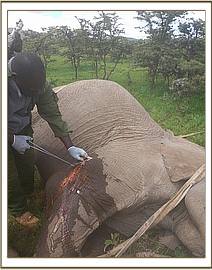

She was then turned over to lie on her right side in order to handle the injury to her left side. This was a very big swelling on her left precruris with pus and necrotic tissue. This was an injury caused by a poisoned arrow which had since fallen out. The injury could have occurred two weeks prior to intervention. The swelling was opened and all the pus drained out. All necrotic tissues were removed and the wound debrided using Hydrogen peroxide and gauze swabs. Probing was negative for foreign body and copious amount of water was used for rinsing. For disinfection, tincture of iodine was applied then the wound was packed with green clay to stop sepsis and hasten healing.
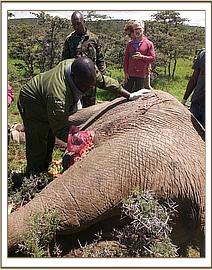

Other treatments instituted include administration of 30000mgs amoxicillin antibiotic and 5000mgs flunixin meglumine anti-inflammatory.
Reversal and Prognosis
Reversal of the anaesthetic was achieved by intravenous administration of 42mgs Diprenorphine hydrochloride delivered through a prominent ear vein. She woke up in four minutes and joined her calf who was waiting with the nearby herd. Her prognosis is good.
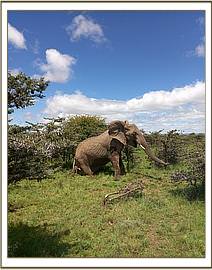

CASE#4 EXAMINATION OF A YOUNG ELEPHANT BULL
Date: 10th May 2018
Species: African elephant
Age: About 16 years
Location: Ngoswani
History
Together with the earlier treated female, this young bull had been identified as a candidate for treatment by Olarro Conservancy Management. He had what appeared to be a spear injury to his right abdomen. This bull was handled after the injured female had been treated.
Immobilization, examination and management
He was restrained chemically by use of 13mgs Etorphine hydrochloride delivered through a 1.5ml dan-inject dart from a vehicle. It took eight minutes for the drugs to take full effect with this young bull assuming sternal recumbency. He was repositioned to lie on his left side for ease of examination of the injury.
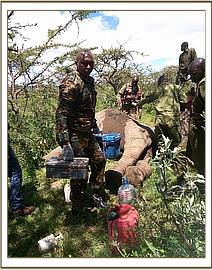

Examination revealed an old spear wound that had since healed with fibrosis leaving a scar. He was given Flunixin meglumine anti-inflammatory and Oxytetracycline antibiotic and was confirmed to be in good condition before being reversed.


Reversal and Prognosis
Reversal of the anaesthetic was achieved by intravenous administration of 36mgs Diprenorphine hydrochloride through a prominent ear vein. He woke up in three minutes to join the rest of the herd. As the wound is already healing his prognosis for recovery is very good.
CASE#5 EXAMINATION OF VULTURE CARCASSES
Date; 13-05-2018
History
There were reports that two vulture carcasses had been found just outside Olarro Conservancy with Olarro management and rangers picking them for onward transmission for sampling. They informed the mobile veterinary unit and were advised to avail the carcasses at the Mara research station for sampling.
Examination and way forward
Two vulture carcasses were Griffon and lappet faced vulture species. Both of them were adults.
Examination revealed the carcasses were over two weeks old and nothing save for the skeleton and feathers remained. No soft body part could be retrieved and nothing meaningful could be sampled from the carcasses. Presented with this, the cause of their deaths could not be determined grossly and viable samples could not be recovered. Given that the two different species were found next to each other, there are possibilities they died under same circumstances and poisoning is suspected.


CASE#6 INJURED BLACK RHINO
Date: 19th May 2018
Species: Black Rhino
Sex: Male
Age: Adult
Location: Lake Nakuru National Park
History
This male black rhino was seen by the rhino team in Lake Nakuru National Park walking with some difficulty on his right hind leg. There was a slight swelling at the level of the hock joint of the affected leg. They requested the mobile veterinary unit’s services to intervene. This rhino was found lying near a water pool after wallowing. He stood up and moved to a small nearby thicket on approach. He could bear weight on the affected limb which appeared swollen at the hock.
Immobilization, examination and treatment
Restraint was achieved chemically by use of a combination of 4.5mgs Etorphine hydrochloride and 70mgs Azaperone tartarate delivered through a 1.5ml dan-inject dart from foot. It took eight minutes for the drugs to take full effect with this male assuming sternal recumbency. A blindfold was put in place and then he was doused with cold water and given 5mgs Butorphanol intravenously to stabilize him.
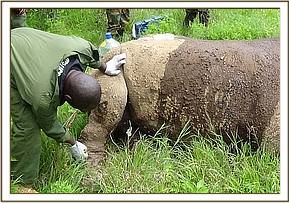

Examination revealed an old dislocation on his right hock joint which appeared healed with instability. Movement, especially with the prevailing muddy conditions hence frequent sliding could have aggravated this long time injury. No wound was detected and scanning with A powerful metal detector was negative for metallic foreign body.
He received 7500mgs Amoxicillin antibiotics and 2500mgs Flunixin meglumine anti-inflammatories parenterally.
Reversal
Reversal of the anaesthetic was achieved by administration of 24mgs Diprenorphine hydrochloride intravenously through an ear vein. He woke up after four minutes, surveyed the surrounding before retreating to the thicket.
Prognosis
Good. The rhino team were advised to constantly monitor and report his progress.
CASE#7 TREATMENT OF A MALE BLACK RHINO
Date: 19th May 2018
Species: Black Rhino
Sex: Male
Age: Adult
Location: Lake Nakuru National Park
History
This big male had been seen with a swelling on his ventral neck by the Rhino Team in Lake Nakuru National Park. According to the team, the swelling appeared to increase in size over time and appeared to be disturbing this rhino who spent most of the time lying down unlike before. He was found lying in an open area with the swelling evident on the ventral aspect of his neck. His body condition appeared good. He stood upon seeing the vehicle approaching but did not move far.
Immobilization, examination and treatment
Restraint was achieved chemically by use of a combination of 4.5mgs Etorphine hydrochloride and 80mgs Azaperone delivered through a 1.5 dan-inject dart from a vehicle. It took ten minutes for the drugs to take full effect and he remained calm before assuming sternal recumbency. A blindfold was put in place, and as the temperature was low with light rain, no water for cooling was needed. He was given 5mgs Butorphanol intravenously to stabilize him before commencement of examination. He was made to lie on his left side for ease of examination and treatment. Palpation and aspiration of the swelling confirmed this as an abscess. The swelling was lanced on its most ventral location with all the pus being drained out. Hydrogen peroxide was used for debridement and gauze swabs to remove all necrotic tissues. Clean water was used for rinsing before tincture of iodine was applied for disinfection. Cloxacillin ointment was infused into the wound to counter sepsis.
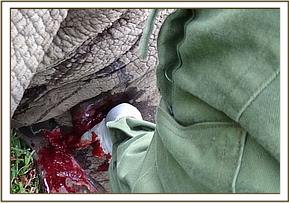

Additionally, this rhino received 7500mgs Amoxicillin antibiotic and 2500mgs Flunixin meglumine anti-inflammatory all intramuscularly.
Reversal and Prognosis
The anaesthetic was reversed by intravenous administration of 24mgs Diprenorphine hydrochloride through an ear vein. He is expected to make full recovery.
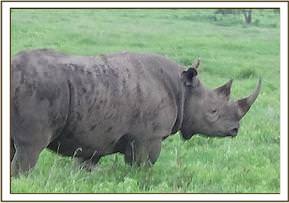
CASE#8 SNARED ZEBRA
Date: 20th May 2018
Species: Common zebra
Sex: Female
Age: Sub adult
Location: Olerai Conservancy
History
This young female was seen by the Conservancy Management with a wire snare round her right fore leg at the fetlock joint. They called the Mobile Veterinary Unit for help. The vet Unit found her with other zebras on an open field limping while walking due to a tight snare around the affected leg.
Immobilization, examination and management
Immobilization was achieved by use of a combination of 5mgs Etorphine hydrochloride and 50mgs Azaperone delivered through a 1.5ml dan-inject dart from a vehicle. The zebra was recumbent after 5 minutes after which she was laid comfortably on her left side for ease of examination. A plain and very tight wire snare was removed from the joint which had eaten into the bone causing severe damage. Further assessment during treatment revealed the strength of the joint had greatly been compromised given that the bones had already been severely damaged with few ligaments supporting it. Fractures were evident and the team felt it was better to stop further suffering of this zebra as she was not going to make it in the wild. She was euthanized with 20% Pentobarbitone sodium given intravenously through the jugular vein and carcass disposed of.

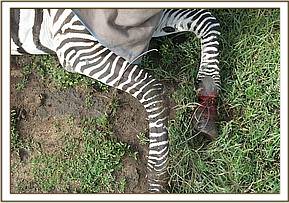

CASE#9 INJURED ELEPHANT
Date: 25th May 2018
Species: African elephant
Sex: Female
Age: Young adult
Location: Mara Triangle
History
This young female was spotted limping while browsing by Mara Triangle rangers on patrol. They called the Mobile Veterinary unit for intervention. This elephant was separate from the rest of the herd and had difficulty while walking. She was limping on her left hind leg.


Immobilization, examination and treatment
Restraint was achieved chemically by use of 13mgs Etorphine hydrochloride delivered through a 1.5ml dan-inject dart from a vehicle. It took ten minutes for the drugs to take full effect with subsequent examination revealing slight swelling of the left knee joint possibly occasioned by a sprain. Treatment involved massaging the swollen area and administration of Flunixin meglumine anti-inflammatories and Oxytetracycline antibiotics, all intramuscularly.
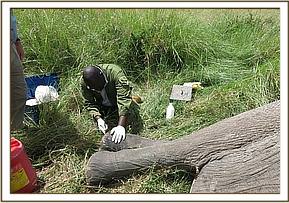

Reversal and Prognosis
Reversal of the anaesthetic was achieved by intravenous administration of 30mgs Diprenorphine hydrochloride through a prominent ear vein. She woke up after four minutes to join the rest of the herd. Her prognosis is good.

CASE#10 INJURED ELEPHANT BULL
Date: 25th May 2018
Species: African elephant
Sex: Male
Age: Adult
Location: Olarro Conservancy
History
This big collared bull christened ‘Limo’ was seen by the Olarro Management Team with KWS security personnel while on their normal patrols. He had a small discharging wound on his right fore leg. They initially thought it had a lodged arrow head. They called the Mobile Veterinary Unit for intervention.
Limo was found with a big mixed herd of over 50 elephants. The wound to his upper right forelimb did not disturb his activities. A decision to immobilise him for further examination was arrived at.
Immobilization, examination and treatment
Immobilization was achieved by use of 18mgs Etorphine hydrochloride delivered through a 3ml dan-inject dart from a vehicle. It took ten minutes for the drugs to take effect with this big elephant assuming sternal recumbency. He was laid on his left lateral side for comfort and ease of examination by pushing and pulling with ropes.


Examination revealed a deep penetrating wound with a round margin and ventromedial course on the lateral upper part of his right foreleg, specifically to the humerus. An exit wound could not be found. Probing showed it was more than 12 inches deep with metal detector confirming there could have been a metallic foreign object lodged deep in the wound. This was probably caused by a low calibre gunshot wound with the projectile getting lodged insitu.
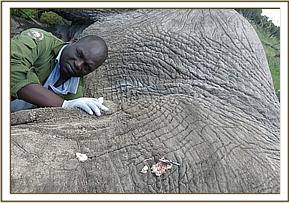

Given this injury appeared not to bother this elephant; the wound was conservatively managed with the hope that the lodged object was non-reactive and that the elephant could live positively with it. The wound was thoroughly debrided with the help of Hydrogen peroxide, rinsed with clean water and disinfected with tincture of Iodine before Cloxacillin wound ointment being infused. Other treatments instituted include, intramuscular administration of 30000mgs Amoxicillin antibiotics and 5000mgs Flunixin meglumine anti-inflammatories.
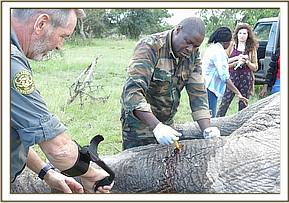

Reversal and Prognosis
Reversal of the anaesthetic was achieved by intravenous administration of 42mgs Diprenorphine hydrochloride through a prominent ear vein. He woke up in four minutes and calmly walked to where the rest of the herd was. Prognosis is favourable. The team was advised to constantly monitor the elephant and report his progress.
CASE#11 INJURED ELEPHANT COW
Date: 26th May 2018
Species: African elephant
Sex: Female
Age: Adult
Location: Olarro Conservancy
History
This elephant was seen by Olarro Conservancy Patrol team with a suppurating wound behind her right shoulder. They called the veterinary unit for intervention. She was found with a bigger herd with an obvious wound on her right side.


Immobilization, examination and treatment
Restraint was done chemically by use of 15mgs Etorphine hydrochloride which was delivered through a 1.5ml dan-inject dart from a vehicle. The drugs took effect after ten minutes and examination revealed a septic spear wound. The wound was thoroughly cleaned with copious amount of water and Hydrogen peroxide before tincture of Iodine was used for disinfection. Green clay was then packed into the wound. She was also given Amoxicillin antibiotic and Flunixin meglumine anti-inflammatories before being reversed with 36mgs diprenorphine hydrochloride.
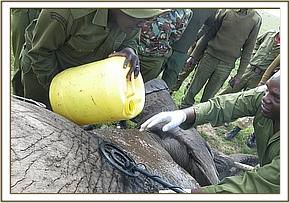

She woke up in three minutes to join the rest of the herd.
Prognosis
Good.
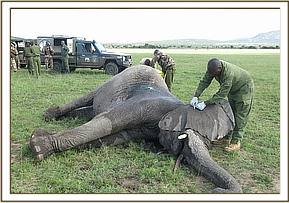

CASE#12 INJURED ELEPHANT BULL
Date: 26th May 2018
Species: African elephant
Sex: Male
Age: Adult
Location: Olarro Conservancy
History
This big bull was seen by Olarro conservancy rangers with a suppurating wound on his right foreleg near his shoulder and a small discharging one on his right thigh. They requested the services of the Mobile veterinary unit for attention. This bull was found alone in an open area, in generally good body condition save for the mentioned injuries.
Immobilization, examination and treatment
Chemical restraint was achieved by use of 18mgs Etorphine hydrochloride delivered through a 3ml dan-inject dart from a vehicle. It took 12 minutes for the drugs to take full effect with this elephant assuming sternal recumbency. He was pushed to lie on his left side for ease of examination and comfort.
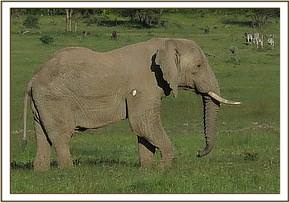

Examination revealed a septic spear wound to his right foreleg just below the shoulder and a deep penetrating wound most likely a gunshot wound on his left thigh. All injuries appeared to involve the soft tissues. All wounds were debrided with Hydrogen peroxide and rinsed with clean water. Tincture of iodine was used for disinfection then Cloxacillin ointment was infused into the wound. Oxytetracycline topical spray was then applied. Other treatments included parenteral administration of Amoxicillin antibiotics and Flunixin anti-inflammatories.It was felt that the lodged object was not disturbing the activities of this elephant and the he could live positively with it.
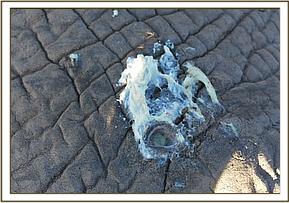

Reversal
Reversal of the anaesthetic was achieved by administration of 42mgs Diprenorphine hydrochloride through the jugular vein. He woke up and moved away after three minutes.
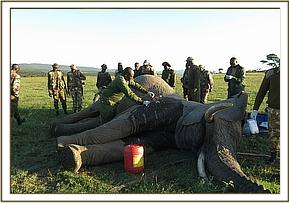

Prognosis
Good. Rangers were advised to monitor this elephant and provide progress update.
Conclusion
Mara Mobile Veterinary Unit is grateful to all stakeholders who partnered with them by reporting and handling wildlife cases who needed attention. Thanks to Minara Foundation through The DSWT for their facilitation to the unit. Thanks too to KWS management for their technical support to the unit. All your inputs are highly appreciated.
